Of all the units that used FM-2 Wildcats with great success, the most successful was VC-27 “The Saints” composite squadron on the USS Savo Island escort carrier. With 61.5 air victories, the VC-27 became the most effective Wildcat carrier squadron. Only one US Navy’s Wildcat squadron shot down more enemy aircraft. It was a VF-5 squadron that shot down seventy-nine victories equipped with F4F-4, but most of them when the unit based on the Henderson Field on Guadalcanal in 1942. The second most effective unit that flew the FM-2 was the VF-26 squadron, which shot down 31 Japanese planes, which is half of the VC-27. The top pilot VC-27 Ralph Elliott, Jr. ended the war as the US Navy most successful Wildcat ace.
The “Saints” are going to war
In May 1943, another US Navy Composite Squadron, a VC-27, was formed. Its task was to fight from the deck of a small escort aircraft carrier and included a bomber squadron and a fighter squadron. After a year of training on SNJ4 and SNJ5 training aircraft, and then on Avengers and F4F-4 Wildcat, the unit received its target aircraft – 12 TBM-1C and 16 FM-2. On 7th July 1944, it boarded the CVE-89 USS Takanis Bay aircraft carrier. From the day of launch, USS Takanis Bay served as a “cruise ship”, and its sole task was to transport entire US NAVY squadrons from the United States to combat zones, and on the way back to take withdrawn units home for rest. Soon sailors began to call it “a flying carpet”.That time, the USS Takanis Bay took a course for Pearl Harbor. During the journey, the VC-27 crew decided to adopt the name “The Saints” in honour of one of the characters of popular Leslie Charteris novels. Older readers probably remember the series with Roger Moore, filmed on their canvas. Leslie Charteris himself gave his written permission to use the image of the “Saint” in a heartwarming letter to the VC-27 airmen. After arriving at Pearl Harbor and another week of a training session in Oahu, on 7th August 1944, the Saints finally boarded the new USS Savo Island carrier. It was the twenty-fourth of fifty Casablanca-class escort carriers built. After another week of training, the Savo Island set off west to the central Pacific war zone. Among the pilots bidding farewell to Hawaii was Ralph Elliot Jr., the main character of this story.
Ralph Elliott, Jr.
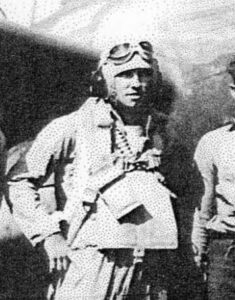 Ralph Earle Elliott, Jr. was born on 22nd August 1920 in Saint Louis, Missouri. He began accounting studies in 1938, but in February 1941 he joined the US Navy as an Air Cadet. Eight months later was commissioned, Ensign. Since December 1941, he served as an instructor at Naval Air Base Corpus Christi in Neuaces County, Texas, and most often flew SNJ training aeroplanes as an instructor. In October 1943 he was promoted Lieutenant and assigned to the VC-27 fighter squadron. After embarking on the USS Savo Island, he followed the entire combat route of this unit from Peleliu to a long and intense Philippines Campaign. Flying Wildcats FM-2 he shot down 9.5 Japanese planes, survived the war and remained in the US Navy, commanding VF-173 and VF-174 fighter squadrons. At the end of his career, he served as a staff officer on the USS Independence. In 1963 he retired, and he lived happily for another 43 years. He passed on 4 December 2006.
Ralph Earle Elliott, Jr. was born on 22nd August 1920 in Saint Louis, Missouri. He began accounting studies in 1938, but in February 1941 he joined the US Navy as an Air Cadet. Eight months later was commissioned, Ensign. Since December 1941, he served as an instructor at Naval Air Base Corpus Christi in Neuaces County, Texas, and most often flew SNJ training aeroplanes as an instructor. In October 1943 he was promoted Lieutenant and assigned to the VC-27 fighter squadron. After embarking on the USS Savo Island, he followed the entire combat route of this unit from Peleliu to a long and intense Philippines Campaign. Flying Wildcats FM-2 he shot down 9.5 Japanese planes, survived the war and remained in the US Navy, commanding VF-173 and VF-174 fighter squadrons. At the end of his career, he served as a staff officer on the USS Independence. In 1963 he retired, and he lived happily for another 43 years. He passed on 4 December 2006.
Peleliu
The first battle of the “Saints” was the bloody invasion of the Marines on Peleliu. Since 12th September, Avengers of VC-27 began bombing and missile attacks on Japanese installations on the island. In the absence of any Japanese opposition in the air, the FM-2 squadron joined its colleagues from the bomb squadron and began strafing the beaches. It soon turned out that there were no enemy planes on Peleliu and the Wildcats started carrying bombs. Attacking ground targets and shipping around the island continued until 27th September, when the island was declared secured. However, the well-hidden remains of the Peleliu garrison fought until the end of October.
The Philippines
In early October 1944, the USS Savo Island was sent to the Southwest Pacific, where it joined the great American Fleet that was preparing for the invasion of the Philippines. On 16th October VC-27 squadron Avengers began attacks on Japanese positions in Leyte Gulf. The Japanese Air Force was practically absent. Thus, Wildcats once again carried bombs and were directed to attack ground targets, mainly enemy airfields at Tacloban, Ormoc, Dulag and San Pablo.
USS Savo Island (CVE-78) photo taken on 3 January 1945 from the deck of the USS West Virginia at Sulu Sea. Photo: United States National Archives and Records Administration, Photo No. 80-G-301851, via C. Lee Johnson, (usndazzle.com).
The Battle of Leyte Gulf
On 24th October 1944, the VC-27 clashed with enemy aircraft for the first time. It was the first day of the battle that was later considered the greatest in the history of naval wars – the Battle of Leyte Gulf. It was the result of a still mighty Japanese Navy attempt to destroy the American invasion fleet. Imperial Japanese Army Air Force and Imperial Japanese Navy Air Force, already relocated to the Philippines threatened by the American invasion, were going to support the ships of the Rising Sun. The Japanese planned to cut off American supply lines, which would isolate their units on the Leyte bridgeheads, and enable the Japanese army to repel the invasion from its very beginning.
That day in the morning, a pair of Ki-43 “Oscar” Japanese fighters attacked one of the Avengers, but the gunner shot down one of them, and the other quickly withdrew from the fight. Later a section of four FM-2s led by Ralph Elliott clashed with four Ki-43s, but the Japanese avoided a fight, and the Wildcats, loaded with additional tanks, could not catch up with them. However, soon four US Navy pilots saw the Yokosuka P1Y “Frances” bomber formation, which was heading towards a group of landing ships moored in the Gulf. The Americans had the height advantage and plunged towards the enemy formation, which began to dive towards American vessels. It quickly became evident that this was a kamikaze attack! Ralph Elliot, in quick succession, shot down two bombers and began to aim for the third, but it was too late. The Japanese crew managed to crash into one of the LST landing ships. Elliott broke aside, attacked other bombers at the back of the formation, and shot down two more. In total, the Americans shot down seven Yokosuka bombers. But that day was not over there. Another VC-27 Wildcat section also clashed with the formation of Mitsubishi Zero fighters which was trying to intercept the group of Avengers and reported nine enemy aircraft shot down. After pilots returned, their reports were verified, and they were credited with fourteen Japanese planes that day with the loss of one Wildcat. However, it was not shot down by the enemy. Its pilot, Ensign Ralph Mayhew, crashed into the surface of the ocean during his unsuccessful attempt to perform a victory roll just above the Savo Island deck.
Battle off Samar
The next day, 25th October, the Battle of Leyte Gulf reached its climax. Admiral Ozawa’s Japanese Task Group, the so-called “Northern Force”, which served as bait, lured Admiral Halsey’s 3rd Fleet with its carriers north of the Philippines. The escort aircraft carriers of the 7th Fleet remained in the Leyte Gulf to support the invasion forces. They became the main target of the Japanese Navy strike force, Admiral Kurita’s “Central Force”, with four battleships, six heavy cruisers, two light cruisers and eleven destroyers. Despite the surprise, the escort carriers managed to repel the enemy attack effectively. This battle, known as the Battle of Samar Island, was described in the article about the Gambier Bay aircraft carrier.
The main Japanese mistake was that the attack of the “Central Force” was not coordinated with the actions of the Japanese air force. The latter stepped into action when the battle almost finished. In the afternoon, the Japanese sent a formation of Aichi D3A “Val” to attack the US Navy escort carriers. The army Ki-44 “Tojo” squadron escorted navy bombers. However, a patrol of “Saints”, commanded by Ralph Elliott, encountered the enemy formation. In a fierce fight, the Wildcat pilots massacred the Japanese escort, reporting shooting down eight Ki-44s. Ralph Elliott claimed three “Tojo’s”, two of which were confirmed after his return to the carrier and one probable. The destruction of the fighter squadron forced Aichi “Val” to retreat and drop their bombs into the sea and return to base. The Americans lost only one pilot missing in combat, but the Wildcats were shot up badly, that five of them had to be written off.
Ki-44 Tojo of the Japanese Army Aviation, eight of them were shot down by CV-27 fighters during Battle off Samar. Photo: Wikipedia.
After the “Central Force” withdrew, fighting in Leyte Gulf continued until 26th October. The defeat of the Japanese Fleet caused a change in Japanese tactics. Kamikaze waves began attacks at the invasion forces. One of the kamikaze pilots managed to sink the escort carrier USS St. Lo. The VC-27 fighter squadron tried to hold Japanese attacks back but had relatively few operational aircraft. During one of the patrols, Ralph Elliott damaged the Japanese Zero, later reduced to shared damage.
On 27th October Wildcats of the “Saints” flew several patrols over the landing ships. Ralph Elliott participated in two of them and managed to shoot down one Aichi D3A “Val”. The next day, new aircraft arrived at the USS Savo Island, bringing the VC-27 to full strength. On 29th October, Elliott made the final flight over Leyte Gulf. On 2nd November, the entire squadron flew to the island of Ponam, one of the Admiralty Islands, for rest and made training flights until 19th November. That day, the ‘Saints” returned to the USS Savo Island, but for almost a month all they did were boring patrol flights.
Battles for Mindoro and Luzon
On 15th December 1944, the VC-27 went into action again. This time the squadron supported the invasion of the island of Mindoro – one of the next liberated Philippine islands on the way to the most important – Luzon. That day, Ralph Elliott Jr. achieved another victory when he shot down a Ki-43 “Oscar” over the Sulu Sea. The USS Savo Island supported the fighting for Mindoro for two days only, before it withdrew to the Manus Island area on 17th December.
VC-27 personnel, photo: www.philcrowther.com
The invasion of Luzon was supposed to begin on 9th January 1945, but as usual, the US Navy had started softening up Japanese defences a few days earlier.
Americans chose not to land on the southern coast of Luzon, opposite the captured island of Mindoro, but in the Lingayen Bay which indents the western shores of the island. This time it was not an easy crossing for the “Saints”, as the Japanese gathered strong air force in Luzon, trying to defend their property in the Philippines for the last time. In the air combat over Lingayen Bay, FM-2 pilots from VC-27 reported shooting down 25 enemy aircraft, but the losses were severe. They lost as many as eight Wildcats and five Avengers. In this phase of the Philippine campaign, on 5th January 1945, Ralph Elliott shot down one B6N “Jill” individually and two planes together with other pilots (0.5 Ki-61 “Tony” and 0.5 J2M “Jack”). Thus, his total account increased to 9.5 confirmed kills.
After the landing of the invasion forces on 9th January, the fighting in the air weakened. From then on, the “Saints” focused mainly on attacks on ground targets. Even though the threat from Japanese fighters was basically over, Elliot almost died in an accident on 10th January 1945. The tailhook in the FM-2 Elliot was piloting jammed and did not catch arresting wires of the USS Savo Island while landing. Fortunately, he managed to ditch right behind it and the destroyer USS Abbott rescued him.
Crash landing of FM-2 BuNo55476/52 on the deck of the USS Savo Island 10 January 1945. Carrier insignia – arrow piercing aeroplane number is visible on tail. Photo US Navy.
On 2nd February, the “Saints” disembarked the USS Savo Island and flew over to the newly prepared airfield on Samar Island. There they boarded a transport ship that took them back to the States. The VC-27 first tour of duty ended.
In the USA the VC-27 squadron was disbanded, but in March 1945 it was re-formed. Its commander was none other than Ralph Elliott Jr. The “Saints”, armed with the new FM-2 and TBM-3, began preparations for the planned invasion of Japan. As you know, the atomic bombs dropped on Hiroshima and Nagasaki led to a faster surrender of Japan. So the VC-27 never returned to combat.
Ralph Elliot Jr. lived to the ripe old age of eighty-six and died on 4th December 2006. His combats during the Philippine campaign made him the most successful US Navy Wildcat ace. The VC-27 squadron with 61.5 air victories turned out to be the most effective Wildcat unit in the US Navy fighting from an aircraft carrier. And all at a time when the Wildcat career as a carrier fighter seemed to be over.
Ralph Elliott Jr. aircraft
During the Philippines campaign, the VC-27 used the FM-2 and TBM-1C in the standard US Navy camouflage of that period. The Avengers wore a tricolour camouflage (Non-Specular Sea Blue/Intermediate blue/White), and the Wildcats were painted Glossy Sea Blue overall. Interestingly, the FM-2 made by Eastern Aircraft had the classic national markings consisting of white stars and stripes on Insignia Blue field, unlike Grumman planes, which had simplified signs painted only white on the navy blue camouflage. Another distinctive feature of the national markings was that the stars and stripes on the upper left wing were light greys instead of white. It was a kind of low visibility marking used on all US Navy navy blue fighters. The “Saints” planes bore small, white individual numbers, probably always two-digit, on their vertical fins and the sides of the engine cowling. On the fins, the numbers were “pierced” with a white oblique arrow, which was an element of the quick identification of the VC-27 squadron.
FM-2 “Baldy”, aeroplane assigned to Ralpha Elliota Jr. with markings of his nine kills, VC-27, USS Savo Island, 1944/45. Artwork by Zbyszek Malicki.
According to VC-27 pilots’ reports, there was a practice of assigning personal planes to some pilots, at least. Ralph Elliott Jr. was one of them and had a “personal” machine. The condition of the aircraft in the squadron changed several times during the tour of duty, and probably Ralph Elliott had different Wildcats at different times. His number was the “thirty-five”, at least at the end of the campaign.
Ralph Elliot Jr in cockpit of his FM-2 #35 „Baldy”. Photo: www.philcrowther.com.
 One photo of FM-2 with the number 35 and lightning on the fin is known from book “Battle baby…” (photo on the left, see references at the end of article). The plane landed on the USS Savo Island, leaning on its nose, and it is difficult to see if it had a number 35 with an arrow on the engine cowling or not. Anyway, apart from the vertical stabilizer and the engine cowling, it had no other markings. It may have been Elliott’s earlier FM-2. However, more famous is his last combat plane with nine Japanese flags under the windscreen. A stylized name “Baldy” was painted white over the victory markings. It was the name of Ralph Elliott’s brother’s favourite German Shepherd. This Wildcat had a small white lightning bolt piercing number 35 on the engine cowling. It is unknown where this designation came from. All the other known Wildcats had the lightning only on the fins. Either it was Elliot’s individual marking, or the last batch of planes on the USS Savo Island had lightning also on the engine covers, or finally, Elliott’s plane was decorated with an arrow for a photoshoot.
One photo of FM-2 with the number 35 and lightning on the fin is known from book “Battle baby…” (photo on the left, see references at the end of article). The plane landed on the USS Savo Island, leaning on its nose, and it is difficult to see if it had a number 35 with an arrow on the engine cowling or not. Anyway, apart from the vertical stabilizer and the engine cowling, it had no other markings. It may have been Elliott’s earlier FM-2. However, more famous is his last combat plane with nine Japanese flags under the windscreen. A stylized name “Baldy” was painted white over the victory markings. It was the name of Ralph Elliott’s brother’s favourite German Shepherd. This Wildcat had a small white lightning bolt piercing number 35 on the engine cowling. It is unknown where this designation came from. All the other known Wildcats had the lightning only on the fins. Either it was Elliot’s individual marking, or the last batch of planes on the USS Savo Island had lightning also on the engine covers, or finally, Elliott’s plane was decorated with an arrow for a photoshoot.
![]() According to the account of the VC-27 weapons officer Forrest Glasgow, the Wildcats of the “Saints” had several characteristic features. For example, the “Baldy” did not have a streamlined propeller hub. The main landing gear wheels most likely did not have hubcaps. In place of the classic round headrest, the “Baldy” received a smaller, rectangular headrest installed on the armoured plate. It also appears that Elliott’s FM-2 had a short tail wheel typical for carrier-based Wildcat, and its undercarriage leg was stripped of its metal cover. Glasgow also mentioned that the Wildcats VC-27 also had rocket launchers, but that could have been the case for the very late FM-2 lots that the “Saints” received in preparation for the 1945 invasion of Japan.
According to the account of the VC-27 weapons officer Forrest Glasgow, the Wildcats of the “Saints” had several characteristic features. For example, the “Baldy” did not have a streamlined propeller hub. The main landing gear wheels most likely did not have hubcaps. In place of the classic round headrest, the “Baldy” received a smaller, rectangular headrest installed on the armoured plate. It also appears that Elliott’s FM-2 had a short tail wheel typical for carrier-based Wildcat, and its undercarriage leg was stripped of its metal cover. Glasgow also mentioned that the Wildcats VC-27 also had rocket launchers, but that could have been the case for the very late FM-2 lots that the “Saints” received in preparation for the 1945 invasion of Japan.
English translation by Dominik Sędziak
You may be interested in:
- VC-27 “The Saints” website devoted to the squadron
- Ralph Elliott Jr i “Święci” Polish language extended story by author
- “Battle baby: a pictorial history of the escort Carrier U.S.S. Savo Island (CVE-78)”, William D. Anderson, US Navy 1946.”
- “Composite Squadron VC-27 United States Navy the Saints” – manuskrypt, Bob Jackson.
 FM-2 Wildcat Model Kit with markings of Lt. Ralph Elliot Jr. and other models in Arma Hobby webstore link.
FM-2 Wildcat Model Kit with markings of Lt. Ralph Elliot Jr. and other models in Arma Hobby webstore link.
A keen modeller since childhood. He is mainly interested in aviation from the times of the First and Second World Wars. He made about a hundred models, wrote a few books and several dozen articles.
Apart from modeling, he is passionate about history, not only the latest one, but also a very distant one. He loves to read journalism, scientific books and science fiction novels. All the time he grumbles that a day should be 50 hours long and he forces himself to go to sleep.
This post is also available in:
 polski
polski



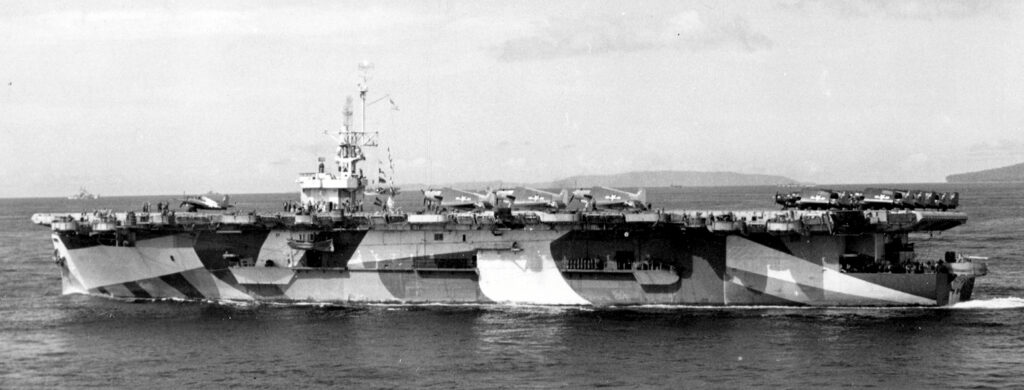



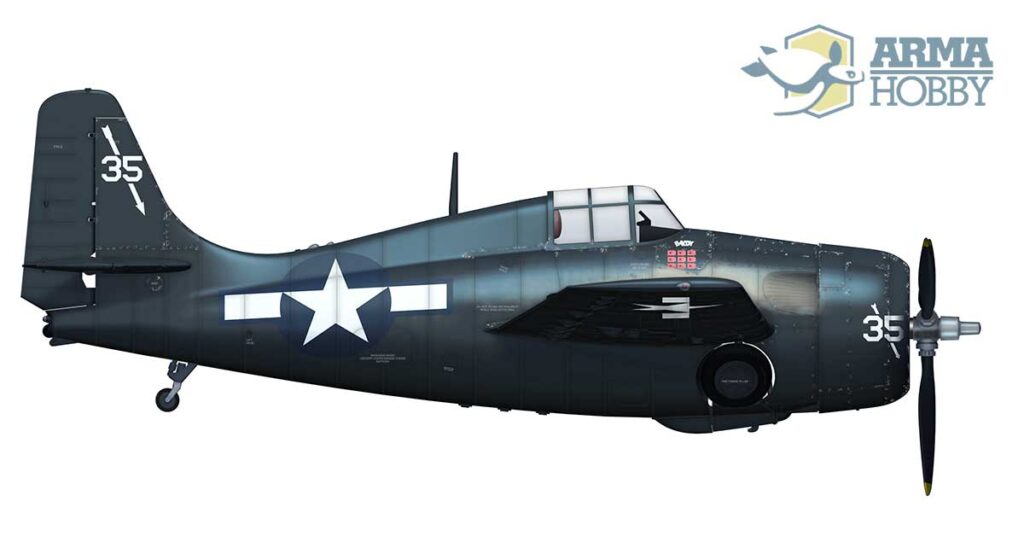
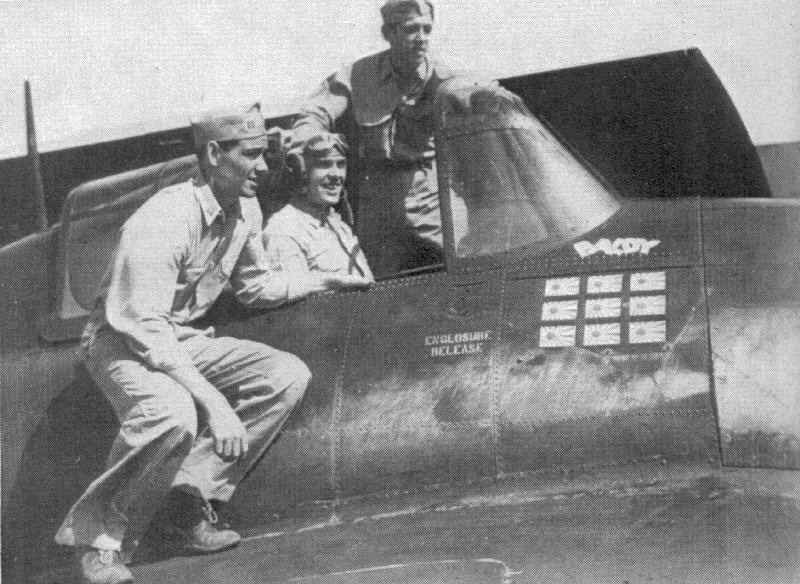
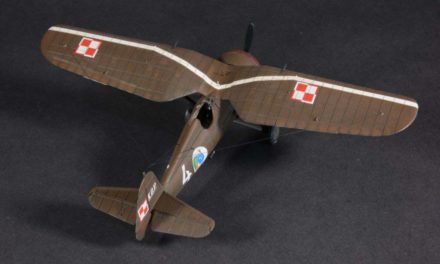


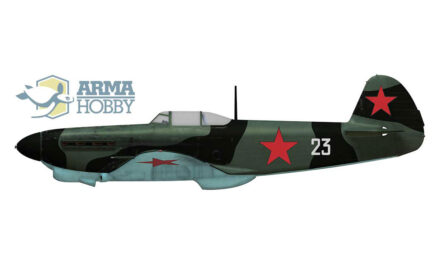
This is an AWESOME resource for historians and modelers! I found the site while researching who the two FM-2 aces were. I found the leading ace’s name AND a color profile of his aircraft! You exceeded my expectations!
Unfortunately, I do not build 1/72nd scale. I am almost exclusively a 1/48th scale fan. However, I have built a 1/32 Stahl Taube because that was the only kit of my namesake aircraft that was available.
My dad was an aircrew member in TBF’s of the Saints off the Savo Island. Thank you for the historical. My dad never said much.